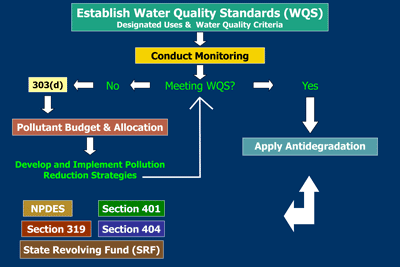Section 404 Program
Section 404 deals with one broad type of pollution—discharge of dredged or fill material into "
waters of the United States". Wetlands are one component of “waters of the United States”; but there are numerous other types—intermittent streams, small perennial streams, rivers, lakes, bays, estuaries, and portions of the oceans.
One of the controversial aspects of section 404 is determining exactly what is and isn’t a wetland. Federal regulations define wetlands as:
“Those areas that are inundated or saturated by surface or ground water at a frequency and duration sufficient to support, and that under normal circumstances do support, a prevalence of vegetation typically adapted for life in saturated soil” [33CFR328.3(b)].
For an area to be declared a wetland, it should exhibit all three of the key features—hydrology, wetland-dependent vegetation, and soil types associated with water-saturated conditions. Some kinds of wetlands, such as bottomland hardwood swamps, however, are dry during some periods. The absence of water or saturated soil at any given moment does not render a plot “not a wetland,” if the vegetation and soils indicate that wet conditions often do occur and hydrological data support this conclusion.
The 404 permit program is administered jointly by EPA and the U.S. Army Corps of Engineers in all but two states. The Corps handles the actual issuance of permits, individual and general. The program also determines whether a particular plot of land is a water of the United States. The Corps has primary responsibility for ensuring compliance with permit conditions, while EPA typically takes the enforcement lead for unpermitted discharges.

![[logo] US EPA](https://www.epa.gov/epafiles/images/logo_epaseal.gif)